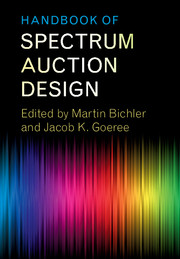Book contents
- Frontmatter
- Contents
- List of Contributors
- Preface
- List of Papers
- Part I The Simultaneous Multiple-Round Auction
- Part II The Combinatorial Clock Auction Designs
- Part III Alternative Auction Designs
- Part IV Experimental Comparisons of Auction Designs
- 25 Experiments Testing Multiobject Allocation Mechanisms
- 26 Laboratory Experimental Testbeds: Application to the PCS Auction
- 27 An Experimental Test of Flexible Combinatorial Spectrum Auction Formats
- 28 On the Impact of Package Selection in Combinatorial Auctions: An Experimental Study in the Context of Spectrum Auction Design
- 29 Do Core-Selecting Combinatorial Clock Auctions Lead to High Efficiency? An Experimental Analysis of Spectrum Auction Designs
- 30 Spectrum Auction Design: Simple Auctions For Complex Sales
- Part V The Bidders’ Perspective
- Part VI Secondary Markets and Exchanges
- Outlook
- References
26 - Laboratory Experimental Testbeds: Application to the PCS Auction
from Part IV - Experimental Comparisons of Auction Designs
Published online by Cambridge University Press: 26 October 2017
- Frontmatter
- Contents
- List of Contributors
- Preface
- List of Papers
- Part I The Simultaneous Multiple-Round Auction
- Part II The Combinatorial Clock Auction Designs
- Part III Alternative Auction Designs
- Part IV Experimental Comparisons of Auction Designs
- 25 Experiments Testing Multiobject Allocation Mechanisms
- 26 Laboratory Experimental Testbeds: Application to the PCS Auction
- 27 An Experimental Test of Flexible Combinatorial Spectrum Auction Formats
- 28 On the Impact of Package Selection in Combinatorial Auctions: An Experimental Study in the Context of Spectrum Auction Design
- 29 Do Core-Selecting Combinatorial Clock Auctions Lead to High Efficiency? An Experimental Analysis of Spectrum Auction Designs
- 30 Spectrum Auction Design: Simple Auctions For Complex Sales
- Part V The Bidders’ Perspective
- Part VI Secondary Markets and Exchanges
- Outlook
- References
Summary
Introduction
The use of laboratory experimental methods in economics has been growing rapidly. With each application, new insights are gained into how the methodology can be used to supplement the more traditional forms of research. Such was the case with the development of the Federal Communications Commission (FCC) policy for the auction of licenses for personal communication systems (PCS). At several different stages the laboratory experimental methods of economics were used. The application differed at each of these stages, representing the different types of relationships that can exist among theory, observation, and policy. This paper is a brief account of the applications.
The use of laboratory experimental data began only after many major decisions had been made by the FCC. The big questions whether or not there should be an auction, what was to be auctioned, and when the auctions were to take place had all been answered. The government had decided that an auction mechanism should be used in place of the classical, administered methods of granting broadcast licenses. The structure of the licenses had been determined, and the time frame and sequences of auctions had been determined.
Wisely, the government separated the decision about the rules that were going to govern the auction from the other decisions. An independent rulemaking process was used to decide what the rules of the auction should be. The FCC's rulemaking process took place in fall of 1993. Decisions were made in the winter and spring of 1994. The first auction of nine (nationwide narrowband) PCS licenses took place in July 1994, and it was followed by the auction of thirty regional narrowband PCS licenses in the fall of 1994. In addition, the FCC conducted an auction of licenses for interactive video data services (IVDS) in July 1994.
By the fall of 1993 the business world was fully aware of the rulemaking process and had engaged many groups of consultants to help them position themselves. Businesses understood that the rules and form of the auction could influence who acquired what and how much was paid. The rules of the auction could be used to provide advantages to themselves or to their competitors. Thus, amixture of self-interest and fear motivated many different and competing architectures for the auctions as different businesses promoted different rules.
- Type
- Chapter
- Information
- Handbook of Spectrum Auction Design , pp. 561 - 587Publisher: Cambridge University PressPrint publication year: 2017



